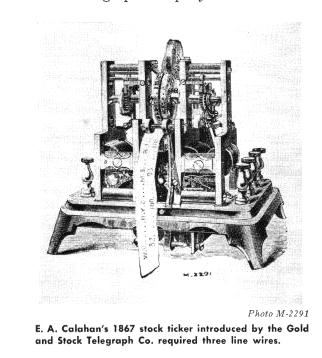Good morning, Whitewater.
We’ll have a sunny and cold Saturday, with a high of twenty-eight, giving way to snowy skies and a half inch of accumulation later this evening.
Whitewater has no tall buildings, but every big city in America does. In the wildly improbably chance that you’re in a skyscraper’s elevator when the cable fails, what’s the best technique for survival? Business Insider offers the answer:

On this day in 1867, the stock ticker debuts in New York City:
Although telegraphic printing systems were first invented by Royal Earl House in 1846, early models were fragile, required hand-cranked power, frequently went out of necessary synchronization between sender and receiver, and did not become popular in widespread commercial use. David E. Hughes improved the printing telegraph design with clockwork weight power in 1856,[2] and his design was further improved and became viable for commercial use when George M. Phelps devised a resynchronization system in 1858.[3] The first stock price ticker system using a telegraphic printer was invented by Edward A. Calahan in 1863; he unveiled his device in New York City in 1867.[4][5] Early versions of stock tickers provided the first mechanical means of conveying stock prices (“quotes”), over a long distance over telegraph wiring. In its infancy, the ticker used the same symbols as Morse code as a medium for conveying messages. One of the earliest practical stock ticker machines, the Universal Stock Ticker developed by Thomas Edison in 1869, used alphanumeric characters with a printing speed of approximately one character per second.
Previously, stock prices had been hand-delivered via written or verbal messages. Since the useful time-span of individual quotes is very brief, they generally had not been sent long distances; aggregated summaries, typically for one day, were sent instead. The increase in speed provided by the ticker allowed for faster and more exact sales. Since the ticker ran continuously, updates to a stock’s price whenever the price changed became effective much faster and trading became a more time sensitive matter. For the first time, trades were being done in what is now thought of as near real-time.
By the 1880s, there were about a thousand stock tickers installed in the offices of New York bankers and brokers. In 1890, members of the exchange agreed to create the New York Quotation Co., buying up all other ticker companies to ensure accuracy of reporting of price and volume activity.[6]
On this day in 1867, a noted artist is born in Wisconsin:
On this date Georgia O’Keeffe was born in Sun Prairie. She studied at the Chicago Art Institute from 1904 to 1905. In 1907 she relocated to New York to study at the Arts Students League with William Chase. In 1926 she unveiled her now famous flower paintings. She received much of her artistic inspiration from her surroundings in New Mexico, where she settled permanently in 1946. O’Keeffe was awarded the Presidential Medal of Freedom in 1977. Georgia O’Keeffe died in 1986 in Santa Fe. [Source: Wisconsin Women: A Gifted Heritage]

